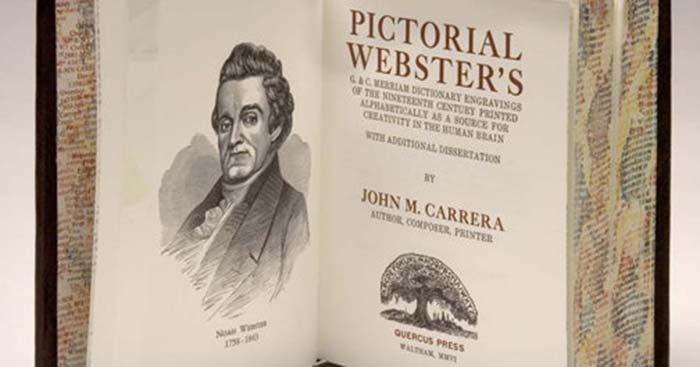Do you remember, as a child, asking a teacher what a word meant and having a dusty, old dictionary dropped into your hands? I can remember flipping through the pages of an unabridged dictionary when I was a wee one and finding those charming illustrations that accompanied the definitions that required more than words. And no matter how many times my cousins assured me, I could never find a dictionary with my picture next to the word gullible.
Homo Narrans
The Pictorial Webster’s—compiled, printed and bound by bookmaker John M Carrera—is a dictionary composed of such illustrations. Over the course of a decade-long journey, Carrera scouted, categorized and organized the original 19th century wood engravings and copper electrotypes that went into the making of some of the earliest Merriam-Webster dictionaries.1 He then retrofitted them to his own linotype machine to create a leather-bound collection of ink and paper curios.
But what he created was more than just a novelty coffee-table book. You can also think of it as a kind of graphic novel. In the prospectus, Carrera calls on readers to treat it like a stream of consciousness story or a “visual Finnegans Wake“.
As readers turn the pages, we can’t help but spot recurring characters, create relationships between the images and develop narratives. Various anthropologists over the years have thought of reclassifying human beings as homo narrans, or ‘the storytelling man’, because we think in narratives.
Old School Bookmaking
Also, if you’re lucky enough to own a copy of one of the limited-run hand-printed editions (alas, I am not), you hold in your hands a case study of the vast history and beauty of bookmaking.
The standard edition is bound in goatskin alum-tawed leather and is styled with fore-edge artwork and type tooled into the leather. Carrera has discussed printing one on vellum as well. And a cloth bound edition is available for you vegans.2
These hand printed Pictorial Webster’s are unique, organic pieces of art. Each copy has a unique relationship with the engravings, with the printing press, with the binder and finally with the reader.
A Relationship with Books
If you weren’t lucky enough to purchase one of the handmade books, there is a trade version too. Because a book doesn’t have to cost $800 or be made from vellum to be beautiful. Maybe it has a bookmark in it from the place you traveled to when you bought it. Maybe you stole it from a friend who you’ve been meaning to give it back to. One of my favorite books is a sun-faded paperback that sat on the passenger seat of my car for one beautiful summer.
When we hold a book—when we cry over one, when we put comments in the margins or write inscriptions to loved ones inside the cover, when we read it out in the rain or stow it away in a dusty attic to be discovered by future generations—we imprint our lives on it. And it warps to our humanity.
- Carrera, John | “The LONG Story of the Project” | Quercus Press | 27 Aug 2013
- “Books” | Quercus Press

